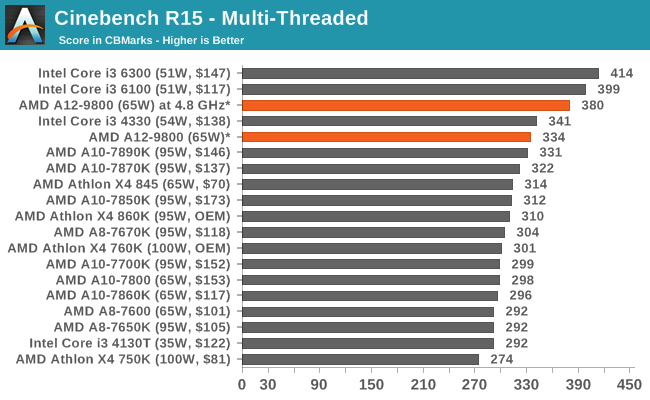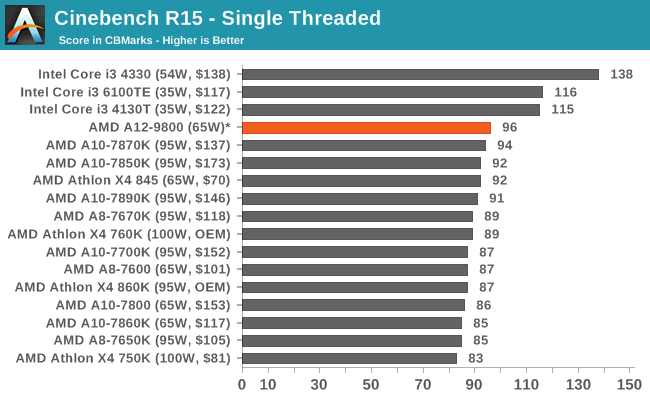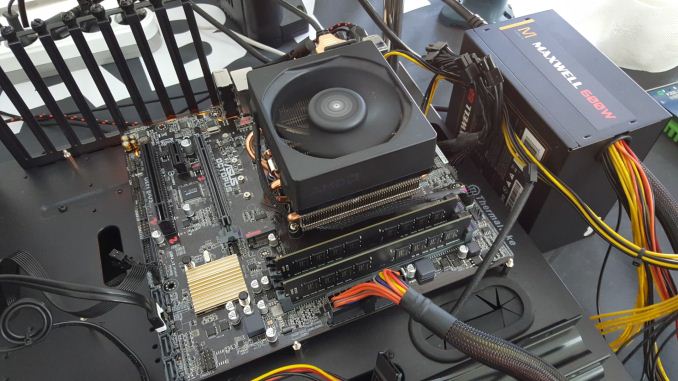AMD 7th Gen Bristol Ridge and AM4 Analysis: Up to A12-9800, B350/A320 Chipset, OEMs first, PIBs Later
by Ian Cutress on September 23, 2016 9:00 AM EST
Over the last two weeks, AMD officially launched their 7th Generation Bristol Ridge processors as well as the new AM4 socket and related chipsets. The launch was somewhat muted, as the target for the initial launch is purely to the big system OEMs and system integrators, such as Lenovo, HP, Dell and others – for users wanting to build their own systems, ‘Product-in-Box’ units (called PIBs) for self-build systems will come at the end of the year. We held off on the announcement because the launch and briefings left a number of questions unanswered as to the potential matrix of configurations, specifications of the hardware and how it all connects together. We got a number of answers, so let’s delve in.
The CPUs
The seven APUs and one CPU being launched for OEM systems spans from a high-frequency A12 part using the 7th Generation microarchitecture (we call it Excavator v2) to the A6, and they all build on the Bristol Ridge notebook parts that were launched earlier in the year but focused on the desktop this time around. AMD essentially skipped the 6th Gen, Carrizo, for desktop as the design was significantly mobile focused – we ended up with one CPU, the Athlon X4 845 (which we reviewed), with DDR3 support but no integrated graphics. Using the updated 28nm process from TSMC, AMD was able to tweak the microarchitecture and allow full on APUs for desktops using a similar design.
The full list of processors is as follows:
| AMD 7th Generation Bristol Ridge Processors | |||||
| Modules/ Threads |
CPU Base / Turbo (MHz) |
GPU | GPU Base / Turbo (MHz) |
TDP | |
| A12-9800 | 2M / 4T | 3800 / 4200 | Radeon R7 | 800 / 1108 | 65W |
| A12-9800E | 2M / 4T | 3100 / 3800 | Radeon R7 | 655 / 900 | 35W |
| A10-9700 | 2M / 4T | 3500 / 3800 | Radeon R7 | 720 / 1029 | 65W |
| A10-9700E | 2M / 4T | 3000 / 3500 | Radeon R7 | 600 / 847 | 35W |
| A8-9600 | 2M / 4T | 3100 / 3400 | Radeon R7 | 655 / 900 | 65W |
| A6-9500 | 1M / 2T | 3500 / 3800 | Radeon R5 | 720 / 1029 | 65W |
| A6-9500E | 1M / 2T | 3000 / 3400 | Radeon R5 | 576 / 800 | 35W |
| Athlon X4 950 | 2M / 4T | 3500 / 3800 | - | - | 65W |
AMD’s mainstream processors will now hit a maximum of 65W in their official thermal design power (TDP), with the launch offering a number of 65W and 35W parts. There is the potential to offer CPUs with a configurable TDP, however much like the older parts that supported 65W/45W modes, it was seldom used, and chances are we will see OEMs stick with the default design power windows here. Also, the naming scheme: any 35W part now has an ‘E’ at the end of the processor name, allowing for easier identification.
As part of this review, we were able to snag a few extra configuration specifications for each of the processors, including the number of streaming processors in each, base GPU frequencies, base Northbridge frequencies (more on the NB later), and confirmation that all the APUs launched will support DDR4-2400 at JEDEC sub-timings.
| AMD 7th Generation 65W Bristol Ridge Processors | |||||
| Modules/ Threads |
CPU Base / Turbo (MHz) |
GPU SPs |
GPU Base / Turbo (MHz) |
Northbridge Base (MHz) |
|
| A12-9800 | 2M / 4T | 3800 / 4200 | 512 | 800 / 1108 | 1400 |
| A10-9700 | 2M / 4T | 3500 / 3800 | 384 | 720 / 1029 | 1400 |
| A8-9600 | 2M / 4T | 3100 / 3400 | 384 | 655 / 900 | 1300 |
| A6-9500 | 1M / 2T | 3500 / 3800 | 384 | 720 / 1029 | 1400 |
| Athlon X4 950 | 2M / 4T | 3500 / 3800 | - | - | 1400 |
| AMD 7th Generation 35W Bristol Ridge Processors | |||||
| Modules/ Threads |
CPU Base / Turbo (MHz) |
GPU SPs |
GPU Base / Turbo (MHz) |
Northbridge Base (MHz) |
|
| A12-9800E | 2M / 4T | 3100 / 3800 | 512 | 655 / 900 | 1300 |
| A10-9700E | 2M / 4T | 3000 / 3500 | 384 | 600 / 847 | 1300 |
| A6-9500E | 1M / 2T | 3000 / 3400 | 256 | 576 / 800 | 1300 |
The A12-9800 at the top of the stack is an interesting part on paper. If we do a direct comparison with the previous high-end AMD APUs, the A10-7890K, A10-7870K and A10-7860K, a lot of positives end up on the side of the A12.
| High-End AMD APU Comparison | |||||||
| A12-9800 | A10-7890K | A10-7870K | A10-7860K | A10-9700 | |||
| MSRP | - | $165 | $137 | $117 | - | ||
| Platform | Bristol Ridge | Kaveri Refresh | Bristol Ridge | ||||
| uArch | Excavator v2 | Steamroller | Steamroller | Steamroller | Excavator v2 | ||
| Threads | 2M / 4T | 2M / 4T | 2M / 4T | 2M / 4T | 2M / 4T | ||
| CPU Base Freq | 3800 | 4100 | 3900 | 3600 | 3500 | ||
| CPU Turbo Freq | 4200 | 4300 | 4100 | 4000 | 3800 | ||
| IGP SPs | 512 | 512 | 512 | 512 | 384 | ||
| GPU Turbo Freq | 1108 | 866 | 866 | 757 | 1029 | ||
| TDP | 65W | 95W | 95W | 65W | 65W | ||
| L1-I Cache | 192 KB | 192 KB | 192 KB | 192 KB | 192 KB | ||
| L1-D Cache | 128 KB | 64 KB | 64 KB | 64 KB | 128 KB | ||
| L2 Cache | 2 MB | 4 MB | 4 MB | 4 MB | 2 MB | ||
| DDR Support | DDR4-2400 | DDR3-2133 | DDR3-2133 | DDR3-2133 | DDR4-2400 | ||
| PCIe 3.0 | x8 | x16 | x16 | x16 | x8 | ||
| Chipsets | B350 A320 X/B/A300 |
A88X A78 A68H |
A88X A78 A68H |
A88X A78 A68H |
B350 A320 X/B/A300 |
||
The frequency of the A12-9800 gives it a greater dynamic range than the A10-7870K (having 3.8-4.2 GHz, rather than 3.9-4.1), but with the newer Excavator v2 microarchitecture, improved L1 cache, AVX 2.0 support and a much higher integrated graphics frequency (1108 MHz vs. 866 MHz) while also coming in at 30W less TDP. The 30W TDP jump is the most surprising – we’re essentially getting better than the previous A10-class performance at a lower power, which is most likely why they started naming the best APU in the stack an ‘A12’. Basically, the A12-9800 APU will be an extremely interesting one to review given the smaller L2 cache but faster graphics and DDR4 memory.
A Wild Overclocker Appears!
Given that technically the systems with the new APUs have been released for a couple of weeks, some vendors have their internal enthusiasts play around with the platform. Bearing in mind that AMD has not announced any formal overclocking support on these new APUs, NAMEGT, a South Korean overclocker with ties to ASUS, has pushed the A12-9800 APU to 4.8 GHz by adjusting the multiplier. To do this, he used an unreleased ASUS Octopus AM4 motherboard and AMD’s 125W Wraith air cooler (which will presumably be bundled with PIBs later in the product cycle).
NAMEGT ran this setup on multithreaded Cinebench 11.5 and Cinebench 15, scoring 4.77 and 380 respectively for a 4.8 GHz overclock. If we compare this to our Bench database results, we see the following

For Cinebench 15, this overclocked score puts the A12-9800 above the Haswell Core i3-4360 and the older AMD FX-4350, but below the newer Skylake i3-6100TE. The Athlon X4 845 at stock frequencies scored 314 while running at 3.5 GHz, which would suggest that a stock A12-9800 at 3.8 GHz would fall around the 340 mark.

(Since writing this, a preview by Korean website Bodnara, using the A12-9800 in a GIGABYTE motherboard, scored 334 for a stock Cinebench 15 multithreaded test and 96 for the single threaded test. We've added this result for perspective.)

When we previously tested the Excavator architecture for desktop on the 65W Athlon X4 845, overclocking was a nightmare, with stability being a large issue. At the time, we suspected that due to the core design being focused towards 15W, moving beyond 65W was perhaps a bit of a stretch for the design at hand. This time around, as we reported before, Bristol Ridge is using an updated 28nm process over Carrizo, which may have a hand in this.
When we asked AMD about overclocking details on the new APUs, the return reply was along the lines of ‘No OEM systems at this time will be unlocked, and no official comment on the individual units. More details will be released closer to the platform launch for DIY users’.












122 Comments
View All Comments
Danvelopment - Tuesday, September 27, 2016 - link
Your processor alone is almost $200. You can buy a motherboard, chassis, 80+ psu (what Dell uses in their optiplex's), (well exclude the aftermarket cooler, extra fans and optical for fun sake), and 4gb ram for $83 including ship(200-157+40)? I'm impressed. Care to spec that up?Plus the price of the parts you were going to add to the $200 machine.
And your choice in bench appears to be severely lacking in benchmarks but I see there aren't many ivy i5s, can get ex lease ivy i7s for about $30 more.
jardows2 - Tuesday, September 27, 2016 - link
I had hoped for more numbers in Bench, but I guess the i3's don't get the same attention here. I didn't really want to link to "rival" review sites here in the comments. Main point was that the Skylake i3's are not that dramatically slower than Ivy i5's.i3-6100 is pricing around $120 USD, $110 on sale. Asus B150M-A/M.2 is about $80, but I live close to a MicroCenter, so their combo deal knocks $30 off that price. Crucial MX300 M.2 for $70, 8GB of DDR4 for $35, 1TB hard drive for raw storage at $45, Case/PS for $65. Use my own license for OS. That comes up to ~$415-$445 for a brand new computer.
Main point, I can get a new computer for not much more than a used computer, once I bring the used computer up to my specification. Having a new computer over a used computer for me is more important than the performance difference of the i5.
Danvelopment - Tuesday, September 27, 2016 - link
It's not really building a new machine if you're reusing old parts, if you're talking the general populace rather than you personally (my target) they won't have the option of moving their Windows license, and there's a clock drop on the i3-6100 relative to the benchmarks earlier.Also a chassis/PSU for $65 doesn't sound like a very good option. Going back to Dell (my old company was Dell heavy so I have a lot of experience with their enterprise lines, HP, Lenovo etc will probably be the same). The Optiplex chassis' were almost entirely toolless, well cooled and the 790 onwards looked decent, albeit not incredible (but a $65 chassis/PSU wouldn't). On top of that they used 80+ PSUs (the 3000/7000/9000 series used Gold, I can't remember if the older ones were the same), proven, quality units. i5/i7 builds also used Q series motherboards with Intel components (such as the NIC).
If you're matching quality like for like then you'd be looking to spend more on the new machine. I'd much rather personally run a secondhand Ivy i5/i7 using quality components. Their consumer lines are garbage from my experience but ex-lease machines are all enterprise devices.
Being able to do something doesn't make it a better option, especially if you drop the quality to do so. Ivy i5, even to the benchmarks above is more powerful, ex-lease component machines are higher quality and even with the above it's still cheaper. It just makes sense.
Danvelopment - Tuesday, September 27, 2016 - link
I don't work there anymore but I liked the Dell enterprise machines so much that I actually bought an (ex-lease) E7240 after I left. i5-4200U, 4GB RAM (I added another 8 that I had lying around), 256GB OEM SSD for $200. I can flip the back off with two screws and access almost everything. And the screen front bezel just pulls off with fingernails, although you wouldn't know it til you tried. You don't have to unbolt the hinges like most laptops.Before I started there they bought Vostros (laptop and desktop) for some reason, rather than the enterprise machines and fark those things. They were the hardest farking things to work on, they literally went out of their way to make it hard. I phased the final ones out just before I left. It was the Vostro 3450 that was my most reviled computer ever. The hard drive was screwed onto the motherboard and you literally had to pull the whole thing apart, lift the motherboard then unscrew the HDD from it. If you took the back panel off, you could have done it from there but they put a small band of plastic on the bottom chassis to prevent it. It literally had no other purpose. If there was no warranty you could take a knife, cut that plastic off and do it directly.
Look at this joke of a thing:
http://www.laptopultra.com/guide/wp-content/upload...
https://i.ytimg.com/vi/6QwZ71iAdLA/maxresdefault.j...
4fifties - Friday, September 23, 2016 - link
If DIY motherboards, which presumably would allow either Bristol Ridge or Summit Ridge, follow the pattern of this OEM board, aren't we consigning Zen to just eight lanes of PCIe 3.0 for discrete graphics? Not necessarily an extinction-level event, but neither is it something gaming enthusiasts will be happy with. Hopefully, motherboard manufacturers won't drop the ball with this.prtskg - Friday, September 23, 2016 - link
I think both Summit ridge and Raven ridge will have better chipset(enthusiast level).KAlmquist - Saturday, September 24, 2016 - link
I take it you are thinking that the AM4 socket has more than 12 PCIe lanes, but that Bristol Ridge doesn't connect them all (sort of like the Intel i7-6800K has 28 PCIe lanes even though it uses a socket that has 40 lanes). That makes sense.My guess is that motherboard manufacturers expect AM4 motherboard sales to be driven primarily by Zen. In the DIY market, even the people who do buy a Bristol Ridge processor may be doing it with the intention of upgrading to a more powerful processor later. So I would expect most motherboard manufacturers would try to do a good job of supporting the Zen-based processors.
MrCommunistGen - Friday, September 23, 2016 - link
It really looks like the connectivity onboard the APU is targeted at what a normal laptop would need. This should be a major design advantage for AMD compared to their previous mobile platforms in terms of power, design & material cost, and platform footprint.- This class of CPU doesn't warrant a x16 PEG Link
- Due to space constraints most non-DTR laptops will have fewer than 4x USB ports - maybe 3+1 USB-based card reader. They can probably use an onboard hub for more if they really need them.
- x4 PCI-E 3.0 M.2 is an option
In fact, other than USB ports, this is probably enough connectivity for most non-enthusiast desktop users as well. This could help BOM and board design costs here as well. The optimistic part of me would love to see that reinvested elsewhere in the system. Realistically I see that split between a lower sticker price and an increase in margins for the system builder.
stardude82 - Friday, September 23, 2016 - link
Almost certainly AMD is just reusing the Carrizo design as a cost cutting measure. There isn't a AMD CPU on the market which a x8 link would bottleneck first.Samus - Friday, September 23, 2016 - link
Nice to see AMD trumping Intel's Crystalwell GPU for half the cost...